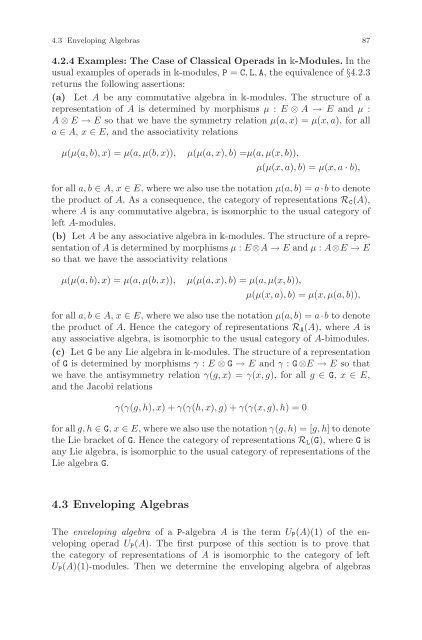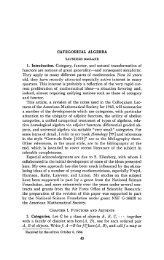Symmetric Monoidal Categories for Operads - Index of
Symmetric Monoidal Categories for Operads - Index of
Symmetric Monoidal Categories for Operads - Index of
You also want an ePaper? Increase the reach of your titles
YUMPU automatically turns print PDFs into web optimized ePapers that Google loves.
4.3 Enveloping Algebras 87<br />
4.2.4 Examples: The Case <strong>of</strong> Classical <strong>Operads</strong> in k-Modules. In the<br />
usual examples <strong>of</strong> operads in k-modules, P = C, L, A, the equivalence <strong>of</strong> §4.2.3<br />
returns the following assertions:<br />
(a) Let A be any commutative algebra in k-modules. The structure <strong>of</strong> a<br />
representation <strong>of</strong> A is determined by morphisms μ : E ⊗ A → E and μ :<br />
A ⊗ E → E so that we have the symmetry relation μ(a, x) =μ(x, a), <strong>for</strong> all<br />
a ∈ A, x ∈ E, and the associativity relations<br />
μ(μ(a, b),x)=μ(a, μ(b, x)), μ(μ(a, x),b)=μ(a, μ(x, b)),<br />
μ(μ(x, a),b)=μ(x, a · b),<br />
<strong>for</strong> all a, b ∈ A, x ∈ E, where we also use the notation μ(a, b) =a·b to denote<br />
the product <strong>of</strong> A. As a consequence, the category <strong>of</strong> representations RC(A),<br />
where A is any commutative algebra, is isomorphic to the usual category <strong>of</strong><br />
left A-modules.<br />
(b) Let A be any associative algebra in k-modules. The structure <strong>of</strong> a representation<br />
<strong>of</strong> A is determined by morphisms μ : E⊗A → E and μ : A⊗E → E<br />
so that we have the associativity relations<br />
μ(μ(a, b),x)=μ(a, μ(b, x)), μ(μ(a, x),b)=μ(a, μ(x, b)),<br />
μ(μ(x, a),b)=μ(x, μ(a, b)),<br />
<strong>for</strong> all a, b ∈ A, x ∈ E, where we also use the notation μ(a, b) =a·b to denote<br />
the product <strong>of</strong> A. Hence the category <strong>of</strong> representations RA(A), where A is<br />
any associative algebra, is isomorphic to the usual category <strong>of</strong> A-bimodules.<br />
(c) Let G be any Lie algebra in k-modules. The structure <strong>of</strong> a representation<br />
<strong>of</strong> G is determined by morphisms γ : E ⊗ G → E and γ : G ⊗E → E so that<br />
we have the antisymmetry relation γ(g, x) =γ(x, g), <strong>for</strong> all g ∈ G, x ∈ E,<br />
and the Jacobi relations<br />
γ(γ(g, h),x)+γ(γ(h, x),g)+γ(γ(x, g),h)=0<br />
<strong>for</strong> all g, h ∈ G, x ∈ E, where we also use the notation γ(g, h) =[g, h]todenote<br />
the Lie bracket <strong>of</strong> G. Hence the category <strong>of</strong> representations RL(G), where G is<br />
any Lie algebra, is isomorphic to the usual category <strong>of</strong> representations <strong>of</strong> the<br />
Lie algebra G.<br />
4.3 Enveloping Algebras<br />
The enveloping algebra <strong>of</strong> a P-algebra A is the term UP(A)(1) <strong>of</strong> the enveloping<br />
operad UP(A). The first purpose <strong>of</strong> this section is to prove that<br />
the category <strong>of</strong> representations <strong>of</strong> A is isomorphic to the category <strong>of</strong> left<br />
UP(A)(1)-modules. Then we determine the enveloping algebra <strong>of</strong> algebras






